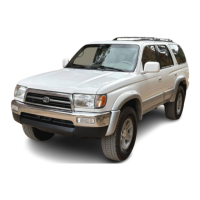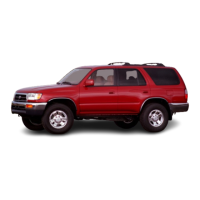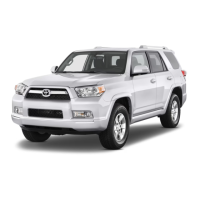Do you have a question about the Toyota 4Runner 1996 and is the answer not in the manual?
Detailed explanation of the vehicle's instrument panel layout and components.
Detailed explanation of the vehicle's instrument panel layout and components.
Description of the gauges, indicators, and controls within the instrument cluster.
Explanation of various warning lights and indicator symbols on the dashboard.
Instructions and procedures related to vehicle keys and door operation.
Instructions for locking and unlocking side doors using keys and interior buttons.
Guide on operating power windows, including driver and passenger controls.
Procedure for locking and unlocking the back door with keys and power lock switch.
Procedure for opening and closing the vehicle's hood.
Instructions on how to open and close the fuel filler door and cap.
Operation of the electric moon roof, including sliding and tilting functions.
Information on adjusting seats, seat belts, steering wheel, and mirrors.
Guidance on adjusting head restraints for safety and proper positioning.
Information on seat belt usage, precautions, and types of occupants.
Explanation of the Supplemental Restraint System (SRS) airbags and their operation.
Guidelines for installing and using child restraint systems safely.
Instructions for adjusting the steering wheel's angle and position.
Operation and maintenance of vehicle lights, wipers, and defogger system.
Operation of headlights, high/low beams, and turn signals.
How to operate windshield wipers and washer fluid spray.
Instructions on how to use the rear window defroster.
Explanation of dashboard gauges, meters, and service reminder indicators.
Explanation of the fuel gauge and low fuel level warning light.
How to read the engine coolant temperature gauge and prevent overheating.
Information on the tachometer and its use for engine speed.
Guide to understanding various dashboard warning lights and buzzers.
Operation of ignition switch, transmission, parking brake, and drive systems.
Operating the automatic transmission, including shift lock and driving modes.
Explanation of front drive control and transfer modes for 4WD operation.
Proper application and release of the parking brake.
How to set, cancel, and use the cruise control system.
Operation of the car audio and air conditioning systems.
Basic operation, controls, and features of the vehicle's audio system.
Controls for fan speed, temperature, air flow, and A/C operation.
Information on various other equipment like clock, lighter, and storage.
Instructions for setting and adjusting the digital clock time.
How to use the cigarette lighter and ashtray.
Procedure for opening and locking the glovebox.
Safety measures and driving tips for off-road conditions to prevent rollover and damage.
Information on fuel type, octane rating, and capacity, including warnings.
Precautions regarding engine exhaust, carbon monoxide, and ventilation.
Details on the tandem master cylinder, brake booster, and ABS system.
Guidelines on tire selection, treadwear, traction, and temperature grades.
Checklist of items to verify before entering and starting the vehicle.
Step-by-step procedure for starting the engine in normal and flooded conditions.
Advice for driving in different conditions like gusty winds, curbs, and wet brakes.
Recommendations for antifreeze, battery, oil viscosity, and door lock care in winter.
Guidelines on weight limits, hitches, brakes, safety chains, and handling when towing.
Tips for improving fuel economy and vehicle longevity through proper driving habits.
Troubleshooting steps for when the engine fails to start or cranks slowly.
Procedure to follow if the engine stops running while the vehicle is in motion.
Steps to take if the engine coolant temperature gauge indicates overheating.
Instructions for safely changing a flat tire, including tool usage and safety precautions.
Recommended towing methods and precautions to prevent vehicle damage.
How to use the shift lock override button to shift out of Park.
Options for obtaining replacement keys and emergency access to the vehicle.
Information on common causes of corrosion and preventative measures.
Guidelines for hand washing, automatic car washes, and waxing the vehicle.
Methods for cleaning vinyl, carpets, seat belts, windows, and interior panels.
Overview of scheduled and general maintenance obligations for vehicle upkeep.
Regular checks for outside and inside the vehicle, including tires and fluids.
Clues indicating service is needed, such as unusual noises or performance changes.
Introduction to DIY maintenance, including engine overview and fuse locations.
Identification of key components and reservoirs in the engine bay.
Location and identification of fuse boxes and individual fuses.
Safety measures and warnings for performing maintenance tasks.
Procedures for checking engine oil, coolant, tires, and other chassis components.
Procedure for checking engine oil level and recommended oil types.
How to check coolant level and type, and identify potential leaks.
Instructions for checking tire pressure and understanding wear indicators.
Importance and procedure for rotating tires to equalize wear.
Guidance on selecting and installing snow tires and chains.
Maintenance and checks for battery, fuses, and light bulbs.
Safety measures and procedures for checking battery condition and electrolyte levels.
Safety guidelines and procedures for recharging the vehicle battery.
How to identify and replace blown fuses with correct amperage ratings.
Instructions and bulb types for replacing various exterior and interior lights.
Vehicle dimensions, wheelbase, tread, and weight ratings.
Engine models, type, bore, stroke, displacement, and spark plug specifications.
Fuel type, octane rating, and tank capacity details.
Tire sizes, recommended cold pressures, and wheel nut torque.
Locations and amperage ratings for various fuse types (A, B, C).
Procedure for reporting vehicle safety defects to NHTSA and Toyota.
Explanation of tire grading systems: Treadwear, Traction, and Temperature.
Detailed explanation of the vehicle's instrument panel layout and components.
Detailed explanation of the vehicle's instrument panel layout and components.
Description of the gauges, indicators, and controls within the instrument cluster.
Explanation of various warning lights and indicator symbols on the dashboard.
Instructions and procedures related to vehicle keys and door operation.
Instructions for locking and unlocking side doors using keys and interior buttons.
Guide on operating power windows, including driver and passenger controls.
Procedure for locking and unlocking the back door with keys and power lock switch.
Procedure for opening and closing the vehicle's hood.
Instructions on how to open and close the fuel filler door and cap.
Operation of the electric moon roof, including sliding and tilting functions.
Information on adjusting seats, seat belts, steering wheel, and mirrors.
Guidance on adjusting head restraints for safety and proper positioning.
Information on seat belt usage, precautions, and types of occupants.
Explanation of the Supplemental Restraint System (SRS) airbags and their operation.
Guidelines for installing and using child restraint systems safely.
Instructions for adjusting the steering wheel's angle and position.
Operation and maintenance of vehicle lights, wipers, and defogger system.
Operation of headlights, high/low beams, and turn signals.
How to operate windshield wipers and washer fluid spray.
Instructions on how to use the rear window defroster.
Explanation of dashboard gauges, meters, and service reminder indicators.
Explanation of the fuel gauge and low fuel level warning light.
How to read the engine coolant temperature gauge and prevent overheating.
Information on the tachometer and its use for engine speed.
Guide to understanding various dashboard warning lights and buzzers.
Operation of ignition switch, transmission, parking brake, and drive systems.
Operating the automatic transmission, including shift lock and driving modes.
Explanation of front drive control and transfer modes for 4WD operation.
Proper application and release of the parking brake.
How to set, cancel, and use the cruise control system.
Operation of the car audio and air conditioning systems.
Basic operation, controls, and features of the vehicle's audio system.
Controls for fan speed, temperature, air flow, and A/C operation.
Information on various other equipment like clock, lighter, and storage.
Instructions for setting and adjusting the digital clock time.
How to use the cigarette lighter and ashtray.
Procedure for opening and locking the glovebox.
Safety measures and driving tips for off-road conditions to prevent rollover and damage.
Information on fuel type, octane rating, and capacity, including warnings.
Precautions regarding engine exhaust, carbon monoxide, and ventilation.
Details on the tandem master cylinder, brake booster, and ABS system.
Guidelines on tire selection, treadwear, traction, and temperature grades.
Checklist of items to verify before entering and starting the vehicle.
Step-by-step procedure for starting the engine in normal and flooded conditions.
Advice for driving in different conditions like gusty winds, curbs, and wet brakes.
Recommendations for antifreeze, battery, oil viscosity, and door lock care in winter.
Guidelines on weight limits, hitches, brakes, safety chains, and handling when towing.
Tips for improving fuel economy and vehicle longevity through proper driving habits.
Troubleshooting steps for when the engine fails to start or cranks slowly.
Procedure to follow if the engine stops running while the vehicle is in motion.
Steps to take if the engine coolant temperature gauge indicates overheating.
Instructions for safely changing a flat tire, including tool usage and safety precautions.
Recommended towing methods and precautions to prevent vehicle damage.
How to use the shift lock override button to shift out of Park.
Options for obtaining replacement keys and emergency access to the vehicle.
Information on common causes of corrosion and preventative measures.
Guidelines for hand washing, automatic car washes, and waxing the vehicle.
Methods for cleaning vinyl, carpets, seat belts, windows, and interior panels.
Overview of scheduled and general maintenance obligations for vehicle upkeep.
Regular checks for outside and inside the vehicle, including tires and fluids.
Clues indicating service is needed, such as unusual noises or performance changes.
Introduction to DIY maintenance, including engine overview and fuse locations.
Identification of key components and reservoirs in the engine bay.
Location and identification of fuse boxes and individual fuses.
Safety measures and warnings for performing maintenance tasks.
Procedures for checking engine oil, coolant, tires, and other chassis components.
Procedure for checking engine oil level and recommended oil types.
How to check coolant level and type, and identify potential leaks.
Instructions for checking tire pressure and understanding wear indicators.
Importance and procedure for rotating tires to equalize wear.
Guidance on selecting and installing snow tires and chains.
Maintenance and checks for battery, fuses, and light bulbs.
Safety measures and procedures for checking battery condition and electrolyte levels.
Safety guidelines and procedures for recharging the vehicle battery.
How to identify and replace blown fuses with correct amperage ratings.
Instructions and bulb types for replacing various exterior and interior lights.
Vehicle dimensions, wheelbase, tread, and weight ratings.
Engine models, type, bore, stroke, displacement, and spark plug specifications.
Fuel type, octane rating, and tank capacity details.
Tire sizes, recommended cold pressures, and wheel nut torque.
Locations and amperage ratings for various fuse types (A, B, C).
Procedure for reporting vehicle safety defects to NHTSA and Toyota.
Explanation of tire grading systems: Treadwear, Traction, and Temperature.
| Brand | Toyota |
|---|---|
| Model | 4Runner 1996 |
| Category | Automobile |
| Language | English |











